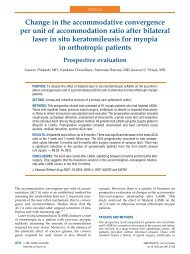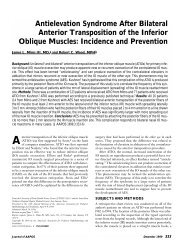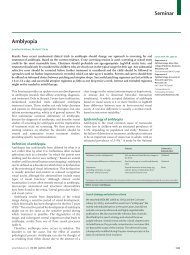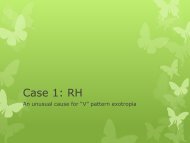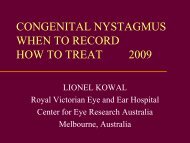What's new AAPOS 2008 - The Private Eye Clinic
What's new AAPOS 2008 - The Private Eye Clinic
What's new AAPOS 2008 - The Private Eye Clinic
Create successful ePaper yourself
Turn your PDF publications into a flip-book with our unique Google optimized e-Paper software.
Orphanet J Rare Dis 2007 Nov; 2(1):43.<br />
This is an excellent review article of OCA, a disorder of melanin biosynthesis. <strong>The</strong>y<br />
note that 1 in 70 people carry a gene for OCA. <strong>The</strong> prevalence varies worldwide with<br />
OCA2 the most prevalent form. <strong>The</strong> diagnosis of OCA is based on clinical findings of<br />
hypopigmentation of hair and skin as well as the characteristic ocular features<br />
(congenital nystagmus, iris transillumination, hypopigmentation of RPE, foveal<br />
hypoplasia and misrouting of optic fibers). However, due to clinical overlap between the<br />
OCA subtypes, molecular diagnosis is necessary to establish the gene defect and OCA<br />
subtype. Molecular genetic testing of TYR and OCA2 are available on a clinical basis,<br />
whereas currently analysis of TYRP1 and MATP is on a research basis only. Carrier<br />
detection and prenatal diagnosis is possible when the mutation has been identified in<br />
the family.<br />
Gene Gene Product Chr.<br />
Localization<br />
Size Disease name Prevalence<br />
TYR Tyrosinase (TYR) 11q14.3 65 kb (529aa) OCA1<br />
1:40,000<br />
OCA1A<br />
OCA1B (Yellow alb.)<br />
OCA2<br />
(p gene)<br />
OCA2 15q11.2-q12 345 kb<br />
(838aa)<br />
OCA2 (Brown OCA in<br />
Africans)<br />
1:36,000 (white Europeans<br />
1:3,900-10,000 (Africans)<br />
TYRP1 Tyrosinase-related protein 1<br />
(TYRP1)<br />
9p23 17 kb (536aa) OCA3 (Rufous OCA) Rare (white Europeans, Asians)<br />
1:8,500 (Africans)<br />
MATP<br />
Membrane-associated<br />
transporter protein (MATP)<br />
5p13.3 40 kb (530aa) OCA4 Rare (white Europeans)<br />
1:85,000 (Japanese)<br />
<strong>The</strong>y briefly review Hermansky-Pudlak syndrome with the accumulation of ceroid in<br />
tissues and exhibiting severe immunologic deficiency. <strong>The</strong>y may develop interstitial<br />
lung fibrosis, granulomatous colitis and mild bleeding problems due to a deficiency of<br />
granules in platelets. Whereas Chediak-Higashi syndrome shows increased<br />
susceptibility to bacterial infections, prolonged bleeding time and peripheral neuropathy,<br />
Griscelli syndrome has immune impairment and /or neurological deficit in addition to the<br />
hypopigmentation. <strong>The</strong> authors recommend sunscreen, as the incidence of skin cancer<br />
may be increased.<br />
Fraser syndrome: A clinical study of 59 cases and evaluation of diagnostic<br />
criteria<br />
Van Haelst MM, Scambler JP, Fraser Syndrome Collaboration Group, Hennekam RC.<br />
Am J Med Genet A 2007; 143(24):3194-203.<br />
This is the largest series to date of 59 patients with Fraser syndrome, an autosomal<br />
recessive congenital malformation syndrome by cryptophthalmos, syndactyly, and<br />
urogenital defects. <strong>The</strong>y compared the existing diagnostic criteria (1986) to the present<br />
data from these patients. <strong>The</strong> authors suggest an adaptation of the diagnostic criteria<br />
for FS by adding airway tract and urinary tract anomalies as major criteria.<br />
Major Criteria<br />
Syndactyly<br />
Cryptophthalmos spectrum<br />
Urinary tract abnormalities<br />
Ambiguous genitalia<br />
Minor Criteria<br />
Anorectal defects<br />
Dysplastic ears<br />
Skull ossification defects<br />
Umbilical abnormalities<br />
66



